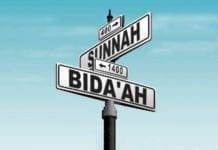Sunnah has been classified in various ways. However, two of the most commonly accepted criteria for such classifications are the subject matter (matn) of Sunnah and the manner of its transmission (isnad).
To begin with, the Sunnah is divided into three types, namely verbal (qawli), actual (fi’li) and tacitly approved (taqriri).
The other division of the Sunnah which will concern us here is its division into legal and non-legal Sunnah.
Verbal, Actual Sunnah and Tacit Approval
The verbal Sunnah consists of the sayings of the Prophet.
The Actual Sunnah of the Prophet consists of his deeds and actual instructions, such as the way he performed the salah…etc. Similarly, the fact that the Prophet authorized mutilation of the hand of the thief from the wrist illustrated, in actual terms, how the Qur’anic ayah (Surah al-Ma’idah’ 5:38) should be implemented.
The tacitly approved Sunnah consists of the acts and sayings of the Companions which the Prophet approved. It may be inferred from his silence and lack of disapproval, or his explicit approval. [25. Abu Zahrah, Usul, p. 89.] An example of such a Sunnah is the report that two of the Companions went on a journey, and when they failed to find water for ablution, they both performed the obligatory prayers with tayammum, that is, wiping the hands, face and feet with clean sand. Later, when they found water, one of them performed the prayers again whereas the other did not. Upon their return, they related their experience to the Prophet, who is reported to have approved both courses of action. Hence it became Sunnah taqririya. [26. Tabrizi, Mishkat, I, 166, Hadeeth no 533; Shawkani, Irshad, p. 41.]
The sayings of Companions such as, ‘we used to do such and such during the lifetime of the Prophet’ constitute a part of Sunnah taqririya only if the subject is such that it could not have failed to attract the attention of the Prophet. An example of this is the saying of Abu Sa’id al-Khudri that ‘for the charity of ‘id al-Fitr, we used to give a sa’ of dates or of barley’. [28. Shawkani, Irshad, p. 61.]
Non-legal and Legal Sunnah
Non-legal Sunnah (Sunnah ghayr tashri’iyyah) mainly consists of the ritual activities[1] of the Prophet (alaf’al al-jibilliyyah) such as the manner which he ate, slept, dressed…etc. Activities of this nature are not of primary importance to the Prophetic mission and therefore do not constitute legal norms. According to the majority of ulema, the Prophet’s preferences in these areas, such as his favorite colors, or the fact that he slept on his right side in the first place, etc., only indicate the permissibility (ibahah). [29. Shaltut, Al-Islam, p. 5 12.]
 The reason is that such acts could be either wajib or mandub or merely mubah. The first two can only be established by means of positive evidence. Since there is no such evidence, there remains the category of mubah. [30. Isnawi, Nihayah] As for the report that the prominent Companion, ‘Abd Allah b. ‘Umar used to imitate the Prophet in his natural activities too, it is held that he did so, not because it was recommended (mandub), but because of his devotion and affection for the Prophet.]
The reason is that such acts could be either wajib or mandub or merely mubah. The first two can only be established by means of positive evidence. Since there is no such evidence, there remains the category of mubah. [30. Isnawi, Nihayah] As for the report that the prominent Companion, ‘Abd Allah b. ‘Umar used to imitate the Prophet in his natural activities too, it is held that he did so, not because it was recommended (mandub), but because of his devotion and affection for the Prophet.]
On a similar note, Sunnah which partakes in specialized or technical knowledge such as medicine, commerce and agriculture, strategy of war, is once again held to be peripheral to the main function of the Prophet and not part of the Shari’ah. [31. Shaltut, Al-Islam, p. 512]
According to the majority, matters regarding which the Prophet had a special ruling, are partly determined by reference to the relevant text of the Qur’an and the manner in which the Prophet is addressed. When, for example, the Qur’an addresses the Prophet in such terms as ‘O you Messenger’, or ‘O you folded up in garments’, it is implied that the address is to the Prophet alone unless proven otherwise. [33. Hitu, Wajiz, p. 273]
Certain activities of the Prophet may fall in between the two categories of legal and non-legal Sunnah. Thus it may be difficult to determine whether an act was strictly personal or intended to set an example. It is also known that at times the Prophet acted in a certain way which was in accord with the then prevailing custom of the community. For instance, the Prophet kept his beard at a certain length and trimmed his moustache. The majority of ulama have viewed this not as a mere observance of the familiar usage at the time but as an example for the believers to follow. Others have held the opposite view by saying that it was a part of the social practice of the Arabs which was designed to prevent resemblance to the Jews and some non-Arabs who used to shave the beard and grow the moustache.c[2]Similarly, it is known that the Prophet used to go to the ‘id prayers (salat al-‘id) by one route and return from the mosque by a different route, and that the Prophet at times performed the hajj pilgrimage while riding a camel. The Shafi’i jurists are inclined to prefer the commendable (mandub) in such acts to mere permissibility whereas the Hanafis consider them as [34. Shawkani, Irshad, p. 35ff] merely permissible, or mubah.
The legal Sunnah (Sunnah tashri’iyya) consists of the exemplary conduct of the Prophet, be it an act, saying, or a tacit approval.











